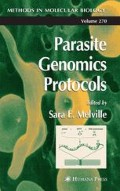Abstract
Methods to transiently and stably transfect blood stages of the human malaria parasite Plasmodium falciparum have been developed and adapted for gene-knockout, allelic replacement, and transgene expression in this organism. These methods are detailed in this chapter, as are approaches used to monitor transfectants during the selection process. The different plasmid vectors that are currently used for gene targeting and transgene expression (including green fluorescent protein expression) are also described.
Access this chapter
Tax calculation will be finalised at checkout
Purchases are for personal use only
References
Wu, Y., Sifri, C. D., Lei, H. H., et al. (1995) Transfection of Plasmodium falciparum within human red blood cells. Proc. Natl. Acad. Sci. USA 92, 973–977.
Crabb, B. S. and Cowman, A. F. (1996) Characterization of promoters and stable transfection by homologous and nonhomologous recombination in Plasmodium falciparum. Proc. Natl. Acad. Sci. USA 93, 7289–7294.
Wu, Y., Kirkman, L. A., and Wellems, T. E. (1996) Transformation of Plasmodium falciparum malaria parasites by homologous integration of plasmids that confer resistance to pyrimethamine. Proc. Natl. Acad. Sci. USA 93, 1130–1134.
Fidock, D. A. and Wellems, T. E. (1997) Transformation with human dihydrofolate reductase renders malaria parasites insensitive to WR99210 but does not affect the intrinsic activity of proguanil. Proc. Natl. Acad. Sci. USA 94, 10,931–10,936.
Crabb, B. S., Cooke, B. M., Reeder, J. C., et al. (1997) Targeted gene disruption shows that knobs enable malaria-infected red cells to cytoadhere under physiological shear stress. Cell 89, 287–296.
O’Donnell, R. A., Freitas-Junior, L. H., Preiser, P. R., et al. (2002) A genetic screen for improved plasmid segregation reveals a role for Rep20 in the interaction of Plasmodium falciparum chromosomes. EMBO J. 21, 1231–1239.
Crabb, B. S., Triglia, T., Waterkeyn, J. G., et al. (1997) Stable transgene expression in Plasmodium falciparum. Mol. Biochem. Parasitol. 90, 131–144.
O’Donnell, R. A., Preiser, P. R., Williamson, D. H., et al. (2001) An alteration in concatameric structure is associated with efficient segregation of plasmids in transfected Plasmodium falciparum parasites. Nucleic Acids Res. 29, 716–724.
Duraisingh, M. T., Triglia, T., and Cowman, A. F. (2002) Negative selection of Plasmodium falciparum reveals targeted gene deletion by double crossover recombination. Int. J. Parasitol. 32, 81–89.
Ben_Mamoun, C., Gluzman, I. Y., Goyard, S., et al. (1999) A set of independent selectable markers for transfection of the human malaria parasite Plasmodium falciparum. Proc. Natl. Acad. Sci. USA 96, 8716–8720.
de Koning-Ward, T., Waters, A., and Crabb, B. (2001) Puromycin-N-acetyltransferase as a selectable marker for use in Plasmodium falciparum. Mol. Biochem. Parasitol. 117, 155–160.
Reed, M. B., Saliba, K. J., Caruana, S. R., et al. (2000) Pgh1 modulates sensitivity and resistance to multiple antimalarials in Plasmodium falciparum. Nature 403, 906–909.
Waller, R. F., Reed, M. B., Cowman, A. F., et al. (2000) Protein trafficking to the plastid of Plasmodium falciparum is via the secretory pathway. EMBO J. 19, 1794–1802.
Wickham, M. E., Rug, M., Ralph, S. A., et al. (2001) Trafficking and assembly of the cytoadherence complex in Plasmodium falciparum-infected human erythrocytes. EMBO J. 20, 5636–5649.
Baldi, D. L., Andrews, K. T., Waller, R. F., et al. (2000) RAP1 controls rhoptry targeting of RAP2 in the malaria parasite Plasmodium falciparum. EMBO J. 19, 2435–2443.
Sidhu, A., Verdier-Pinard, D., and Fidock, D. (2002) Chloroquine resistance in Plasmodium falciparum malaria parasites conferred by pfcrt mutations. Science 298, 210–213.
Author information
Authors and Affiliations
Editor information
Editors and Affiliations
Rights and permissions
Copyright information
© 2004 Humana Press Inc., Totowa,NJ
About this protocol
Cite this protocol
Crabb, B.S. et al. (2004). Transfection of the Human Malaria Parasite Plasmodium falciparum . In: Melville, S.E. (eds) Parasite Genomics Protocols. Methods in Molecular Biology™, vol 270. Humana Press. https://doi.org/10.1385/1-59259-793-9:263
Download citation
DOI: https://doi.org/10.1385/1-59259-793-9:263
Publisher Name: Humana Press
Print ISBN: 978-1-58829-062-5
Online ISBN: 978-1-59259-793-2
eBook Packages: Springer Protocols

